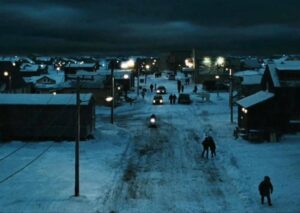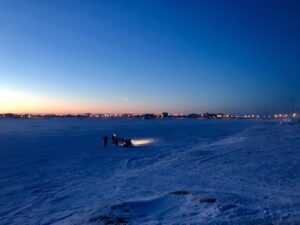 The next time you are upset about short winter days, think about Utqiagvik (formerly Barrow), Alaska…why do they keep changing the names of everything. The residents of America’s northernmost town had their final sunset last year on November 18, 2024, at 1:27pm. They will not see the Sun again until January 22, 2025, at 1:15pm. For those wondering, that is 65 straight days, or 1,560 hours, of darkness! If you happen to suffer from SAD (Seasonal Affective Disorder), you know that the shorter winter days can feel depressing. So just imagine having no sun at all for 65 days!!
The next time you are upset about short winter days, think about Utqiagvik (formerly Barrow), Alaska…why do they keep changing the names of everything. The residents of America’s northernmost town had their final sunset last year on November 18, 2024, at 1:27pm. They will not see the Sun again until January 22, 2025, at 1:15pm. For those wondering, that is 65 straight days, or 1,560 hours, of darkness! If you happen to suffer from SAD (Seasonal Affective Disorder), you know that the shorter winter days can feel depressing. So just imagine having no sun at all for 65 days!!
For most of us, it would be hard to imagine, going through that once, but every year? Yes, in Utqiagvik this is a yearly event. The reason is that everyone who lives above the Arctic Circle, will experience a day when the Sun sets for the rest of the winter. It is a fact of life, and those people who live there year-round, either like it and the novelty of it, or they accept it as a fact of life. Of course, on the flip side, the opposite event is also true, and the sun will return, and eventually will not set for days on end.
Due to its location, just 1,300 miles south of the polar North Pole, Utqiagvik experiences this long polar night.  Another contributing factor is the fact that the Earth orbits the Sun at a 23.5° tilt. During winter, areas near the poles tilt away from the Sun, leaving them with little or no sunlight. For the North Pole, this period lasts from September to March, so during that time, their daily amount of sunlight is limited, and at some points, severely limited, or nonexistent.
Another contributing factor is the fact that the Earth orbits the Sun at a 23.5° tilt. During winter, areas near the poles tilt away from the Sun, leaving them with little or no sunlight. For the North Pole, this period lasts from September to March, so during that time, their daily amount of sunlight is limited, and at some points, severely limited, or nonexistent.
While Utqiagvik residents did not see the Sun during this polar night period, they did still have some light during the day. This is due to the strange phenomenon known as “civil twilight” or the bending of the Sun’s rays around the Earth, so that they appear just above the horizon. The “civil twilight” creates beautiful blue, orange, and pink hues as the Sun’s rays scatter through Earth’s atmosphere. Initially, this twilight will last for about six hours each day. But by mid-December, it will shorten to just three hours as the North Pole tilts further away from the Sun.
Because of its location, Utqiagvik is the first Alaskan town to experience a polar night each year. Nevertheless, it is not the only one. In the late weeks of November, residents of Kaktovik, Point Hope, and Anaktuvuk Pass will also say goodbye to the Sun for a few months. Northern regions of Finland, Norway, Sweden, and parts of  Scotland also experience this phenomenon, though for shorter periods of time.
Scotland also experience this phenomenon, though for shorter periods of time.
While the lack of sunshine would seem punishing for most of us, there is a consolation prize for these hearty residents of the most remote parts of the planet. While the “polar night” is an annual phenomenon, so is the “midnight sun.” The “midnight sun” is their reward for their endurance of the “polar night.” During the summer months, they get to enjoy the “midnight sun” from May 12, 2025, to July 31, 2025, during which time the Sun remains visible both day and night. For Utqiagvik, this will mean no sunset for 82 consecutive days!! The good news…their days of sunshine are actually more than the days of darkness.


Leave a Reply